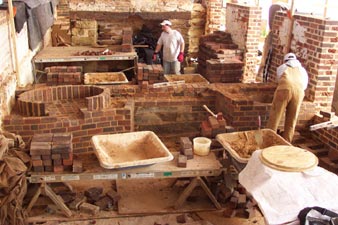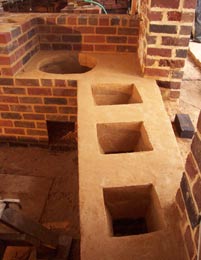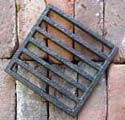|
MASONS BEGIN REBUILDING COOKING FACILITIES
Poplar Forest Newsletter, Spring 2002
The favorite room of any house is the kitchen, and this year visitors for the
first time will see what the kitchen facilities were like at Poplar
Forest.
 Masons
began work in late winter on the cooking area of the kitchen, which is the
second room in the wing, and measures 24 x 15 feet. Along the east end of the
room sat an oven, fireplace, set kettle, and stew pot range. Masons
began work in late winter on the cooking area of the kitchen, which is the
second room in the wing, and measures 24 x 15 feet. Along the east end of the
room sat an oven, fireplace, set kettle, and stew pot range.
The cooking options in the kitchen, says the director of architectural
restoration, Travis McDonald, represents a very sophisticated operation.
“A typical house of no pretense in
America
at that time would have had a fireplace,” he notes. “Better ones would have
had ovens too.”
Set kettles would have been few and far between, and stew pots even rarer.
 It
was in the set kettle that the cook Hannah would keep a constant supply of hot
water. The kettle was recessed into the masonry, with just a one-inch lip
showing. Underneath, coals would heat the water. It
was in the set kettle that the cook Hannah would keep a constant supply of hot
water. The kettle was recessed into the masonry, with just a one-inch lip
showing. Underneath, coals would heat the water.
Last year
Poplar
Forest
received an 18th century set kettle, a timely donation from
architect John Mesick.
Equally intriguing is the stew stove. Found in
Europe
but rare in
America, the stoves were used for cooking sauces, something one couldn’t do well in a
large fireplace where it was difficult to regulate the temperature. McDonald
believes this was yet another innovation that
Jefferson
saw in
France
and brought home. The stew stove was a masonry structure with iron grates along
the top and a space underneath for burning coal.
Archaeologists excavated the kitchen from the fall of 1989 through the spring
of 1991. They found surviving evidence of walls dividing the kitchen from
adjacent rooms, the brick floor, the hearth area, chimney base, and the location
of the set kettle.
Other evidence includes a changing brick pattern in the floor near the hearth
indicating the location of the stew stove, and surviving bricks from the
original oven.
 They
also recovered an iron grate for the stew stove mixed in with debris from the
destruction of the wing in the 1840s. In
the yard in front of the kitchen, archaeologists found thousands of artifacts
including fragments of a brass kettle, broken ceramics, wine bottle and drinking
glasses, pieces of forks and knives,
and bones from cows, pigs, and chicken. Tiny
artifacts found within a deposit of ash associated with the kitchen hearth
included fish bones, glass beads, straight pins, and seeds. They
also recovered an iron grate for the stew stove mixed in with debris from the
destruction of the wing in the 1840s. In
the yard in front of the kitchen, archaeologists found thousands of artifacts
including fragments of a brass kettle, broken ceramics, wine bottle and drinking
glasses, pieces of forks and knives,
and bones from cows, pigs, and chicken. Tiny
artifacts found within a deposit of ash associated with the kitchen hearth
included fish bones, glass beads, straight pins, and seeds.
|
 Masons
began work in late winter on the cooking area of the kitchen, which is the
second room in the wing, and measures 24 x 15 feet. Along the east end of the
room sat an oven, fireplace, set kettle, and stew pot range.
Masons
began work in late winter on the cooking area of the kitchen, which is the
second room in the wing, and measures 24 x 15 feet. Along the east end of the
room sat an oven, fireplace, set kettle, and stew pot range. It
was in the set kettle that the cook Hannah would keep a constant supply of hot
water. The kettle was recessed into the masonry, with just a one-inch lip
showing. Underneath, coals would heat the water.
It
was in the set kettle that the cook Hannah would keep a constant supply of hot
water. The kettle was recessed into the masonry, with just a one-inch lip
showing. Underneath, coals would heat the water. They
also recovered an iron grate for the stew stove mixed in with debris from the
destruction of the wing in the 1840s.
They
also recovered an iron grate for the stew stove mixed in with debris from the
destruction of the wing in the 1840s.